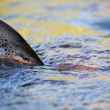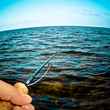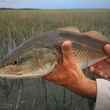It's not every day you are greeted by the smell of bait at your doorstep and is rarer still to revel in such a fishy odor wafting through your neighborhood. But there I was, following my sense of smell from my house in Melbourne, Florida to the ocean, several blocks away. I climbed the boardwalk steps and just past the shore break was a mass of pogy, swimming south.
Finned, feathered, flippered, and flip-flopped predators—like me—were there enjoying the spoils of conservation. The awe-inspiring sight of the pogy served as a reminder of how far we've come and just how high the stakes will be for "the most important fish in the sea" and for anglers this November 14. That's when the Atlantic States Marine Fisheries Commission is scheduled to vote on a plan that could transform the management of Atlantic menhaden from a narrow single species approach—which ignores the value of recreational fishing—to a big picture approach that will protect menhaden and their role in the ecosystem and our fisheries.
It's hard to imagine a fish that means more to the east coast than Atlantic menhaden. Virtually every region has its own term of endearment to describe these oily forage fish. Call them pogy, fat-back, bunker, bughead, or by the Native American vernacular (and mouthful )"munnawhatteaûg," but please don't underestimate menhaden's keystone role in east coast fisheries and marine ecosystems.
Menhaden are small, short-lived, a key food source for a myriad of predators from table fare to massive marine mammals and are historically abundant from Maine to Florida. Striped bass, tarpon, bluefin tuna, humpback whales, and osprey are just a few notable members of the Menhaden Diners Club. And when the smelly menhaden dinner bell rings, the feeding frenzy is an incredible sight to behold.
Such gatherings are profitable too. Schools of menhaden and other forage fish lure and concentrate predators for people to see and catch. Fishermen, whale-watching tours, restaurants and more reap the spoils in the form of booked trips, photos and fresh local seafood. And if my friends' social media feeds are any indication, this year has been a very good one for many guides in the northeast.
Menhaden schools like the one I sniffed out are a good sign for a species that once endured decades of overfishing by commercial fishing fleets. The advent of large scale fishing capacity and an improving U.S. economy following World War II meant that more menhaden than ever could be removed from the ocean to be used as bait and reduced into fish meal and fish oil. To this day menhaden are incorporated into a multitude of products from livestock and pet feed, to omega-3 capsules, to cosmetics.
The menhaden fishery quickly became the biggest on the U.S. east coast lacking an annual science-based catch limit and accountability measures, which are norms for other popular species. A total of 25 menhaden processing plants sprouted up and down the Atlantic, including one in Jacksonville, Florida. This unbridled expansion depleted menhaden at the cost of both predators and local economies. Today, just one processing plant remains, based at the heart of the menhaden's range—the Chesapeake Bay—where the bulk of the remaining population grow up.
A turning point for conservation of this important species came in 2012, when a coalition of recreational and commercial fishermen, conservation organizations, coastal business owners and more aligned their efforts in support of the first ever coastwide catch cap for Atlantic menhaden. The coalition's might, coupled with the bravery of representatives from Florida and other Atlantic State Marine Fishery Commission (ASMFC) states, helped pass Amendment 2, which resulted in a 20 percent reduction in coastwide catch. In terms of numbers of fish, Amendment 2 meant that each year, three hundred million more menhaden would remain in the water to enrich our fisheries.
Since that historic day, menhaden have been on the road to recovery. A 2015 stock assessment indicates that the menhaden population has been growing and its range increasing and hopes are that the 2017 stock assessment, due out this summer, will show continued progress toward rebuilding.
The commercial menhaden fishing industry has used this ongoing menhaden rebound to argue for a reversal of course, advocating for large quota increases of 20 to 40 percent. Pushback from anglers, conservationists, scientists, and more has slowed their progress, but after several years the commercial fleet's quota is again nearing 2011 levels. This seemingly unstoppable erosion of past conservation gains is proof positive that the ASMFC's antiquated, single species approach to managing menhaden, which ignores impacts to predators and other fisheries, is by far the industry's greatest asset and the recreational angler's greatest foe.

This tiresome struggle is likely to continue until we come up with a new way to manage menhaden that accounts for their worth in landings as well as when left in the sea, enabling the population to fully recover and return to its historic range. Down here in the southern extent of the menhaden's range, fishermen and birders alike long for that day.
A Path Forward for Menhaden
The ASMFC is currently working on new rulemaking, known as Amendment 3, which would finally establish the ground rules necessary to manage menhaden to meet the needs of both commercial fishermen and the menhaden's many predators. By establishing what are called ecological reference points (ERPs), Amendment 3 would set the bar for menhaden recovery based on how much menhaden are needed to keep striped bass, tarpon, osprey and other species healthy. If the menhaden population were to drop below a level thought to jeopardize their ability to recover and support healthy predator populations, then the commercial menhaden fishery's quota would be reduced until the menhaden population could recover.
Based on the most recent meeting of the Commission's menhaden advisory panel in June 2017, draft Amendment 3 will include several options for ERPs ranging from continued single-species management to a 21st century, ecosystem-based approach. Specifically, the option specifying that the ASMFC's "BERP continues to develop menhaden-specific ERPs with interim use of 75% target, 40% threshold" puts into practice as soon as possible what fishermen, scientists, and conservationists agree is the path forward. This option means the ASMFC will manage menhaden for their role as prey based on widely-applicable guidelines supported by numerous peer-reviewed studies. And, long-term, this option supports the development of ERPs specific to Atlantic menhaden, which are expected to take at least several more years for the ASMFC's Biological Ecological Reference Points (BERP) Working Group to develop.
Such ecosystem-based management would finally mean that menhaden are given the respect that they deserve. But, just like in 2012, none of this is going to happen without strong public support. And no community has more invested, more to gain or lose, and more to say than recreational fishermen.

Take the Pledge and Heed the Call
The ASMFC will meet August 1-3, 2017 to approve draft Amendment 3 for public comment. By September the ASMFC will have released the draft Amendment 3 and initiated the approximately 30 to 45 day public comment period. That comment period will be one of the last and best opportunities for anglers to make themselves heard.
The ASMFC will hold at least one public hearing in Florida and, if the last comment period is any indication, this could be the only hearing held in the southeast. Florida's ASMFC representatives will be there to gather the public's input. And it's this input that will weigh heavy on their minds come on November 14, 2017 when the Commission meets near Baltimore, Maryland to finalize Amendment 3 and set the course for the future of menhaden and all the wildlife and people who depend on them.
Anglers like you and I who care about gamefish from striped bass to tarpon should raise a battle cry in support of the continued development of menhaden-specific ERPs with interim use of 75% target, 40% threshold. We should pledge to share our message and others like it far and wide, speak up at our local public hearings and submit written comments on the record this fall.
Pogy are knocking. Will you heed the call?
To receive details on where and when to comment on Amendment 3 and keep tabs on Florida's other forage fish, please take the Florida forage fish pledge at www.floridaforagefish.org.































Comments